



[Malachi's Homepage] [Origami Homepage] [Business Card Origami] [Business Card Origami Photos] [Business Card Origami Flickr Group]
This page represents a fairly comprehensive collection of origami business card models that I am aware of and that I have made. There are several represented here that I do not know how to make, but I hope to eventually reverse engineer them or learn them some other way.
One of the simplest business card modular units, this cube has many applications because it is easy to make, can be easily faced with additional cards, and can also be easily interlocked with orthagonally adjacent cards.
I do not know who first came up with this model, but I would assume that many people have discovered it at various times due to its simplicity.
I have personally constructed:




This is a problematic unit. Not because it is hard to fold or even that difficult to assemble, although that can be a bit tricky. No, this is a problematic one because of the intellectual property issues around it. Valerie Vann is widely held to be the designer of this unit, although there was a suggestion that it was a parallel invention. I came to it by studying the photos available on the internet. Apparently, when this model was first created and distributed, there were heated discussions about these events back in 1996. (Unfortunatly, the old origami-l server is gone, so I don't have a link to the original discussions.) The crux of the issue is that Valerie Vann's design was reverse engineered by someone who had recieved a completed model and that person taught the model to others. Vann felt this was unfair because she wanted to have control over the model and to recieve credit for the design. The fact that I am presenting the information that I am here is likely to upset some people, but I am doing it anyway for the following reasons:
Crease Pattern: Now that you know the score, or at least my understand of it, you get to decide if you want the FORBIDDEN KNOWLEDGE. If you follow that link, you might need to consider yourself an origami vandal. If you want a challenge, you could ignore the link and try to figure out the model on your own, either by looking at the pictures of finished models or by playing with business cards on your own until it comes to you. If you do it the latter way, without any real knowledge of the unit, then you could even say that you have found it in parallel and claim it as your own. We all have choices to make.








Several of these are pictured on Vann's old site.
I stumbled across the design of this unit while trying to reverse engineer some other units I had seen pictures of, but I believe this is an example of parallel discovery. To the best of my knowldege, the only use for this unit is a six card cuboctahedra.


I do not know if this model is a parallel design or not. I stumbled across it, but I can only assume I was not the first to do so.
Square Cuboctahedra Unit Instructions
Here are alternate instructions which attribute the model to Mosely/Kawamura.
Crease Pattern:

This model has a sister model where two of the corner flaps are swapped, creating a six card, rectangular faced truncated tetrahedra. It is documented as "Tetra'Hiro'n" in the Origami USA 2001 Collection by Hiro Okamoto.

My first effort to reverse engineer a business card unit based on pictures of finished models was Jennifer Campbell's Diamond Edge Unit. It took me a bit of trial and error, but I finally managed to come up with something that seemed to be the same as the unit in the pictures. I was eventually able to get in contact with Jennifer Campbell and confim that this is basically how she made her units, with just a slight variation in the actual construction path. Later, I found Valerie Vann's diagrams for the cube construction at archive.org
Diamond Edge Unit Instructions
Diamond edge crease pattern:
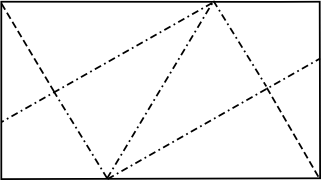
Alternate flap crease pattern for square faced construction:

I have made the following with variations of this unit:











This is another of Jennifer Campbell's units that I did some work reverse engineering before getting some additional information from her about them.
Crease pattern:

The additional light dotted lines in the crease pattern are the lines that are crease for some of the constructions, but are best, in my opinion, creased after the units have been put together. The crease direction varies depending on the number of units.
I have used this unit for the following variations:








Two of these units can be combined to make a tetrahedra, but they have to have reversed handedness from each other to work that way. I'm not really that fond of this unit, as it is not very stable.
Sources say that Jeannine Mosley is the creator of this unit, but it was also independently discovered by Kenneth Kawamura.
There are several known combonations for this unit. Here are the ones I know of, there are probably many others that I am not aware of and they may all require combonations of handedness:
Many of these are Johnson solids and are documented by Tom Hull.
Crease Pattern:

These modulars involve lining up cards at an arbitrary angle and creasing the overlapping edges to create rhombic faces. They can be combined in several different ways. Some constructions require half of the units to be of the opposite handedness.
I believe that Jeannine Mosely's 12-card 1:sqrt2 rhombic dodecahedra found in Jennifer Campbell's pictures is a variant of this pattern.
One example crease pattern:

Mette Pederson's book, Mette Units 4: Rings, has at least one design, Ring 5, that works very well with 12-14 business cards. Because it is in a currently available publication, I won't detail the folding method here, but it is similar to several other ring type designs.
I have constructed this with both 12 and 14 units. A friend of mine has made one with 8 units, but that is not as stable. With these units, the end result resembles a series of squares that are woven together. I have made one using 4 cards of a different color and inserting them every three cards to create the illusion of a single square of a different color woven into the pattern.
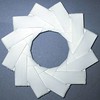
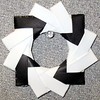
Stern Gudrun ring diagrams by Carmen Sprung. Use 8 business cards.
This is similar to a waterbomb base butteryfly unit that can be put together in a similar way. 12 of these units will make a cuboctahedra, but it is a very unstable structure. It can be entertaining to throw it up in the air and watch the units come apart and flutter back down to the ground.

The construction of a unit is with a mountain fold across one of the long diagonals, a valley fold across the other long diagonal, and then a mountain fold in half, across the short axis. The colapsed unit should bring two of the corners together, with the other two at opposite ends of two conjoined triangular faces. Those tips become tabs that insert into the sides of the next unit, or vice versa, but that alternative construction is much less stable and very difficult.
I do not know the origin of this model.
Crease pattern:
![[Butterfly unit crease pattern]](images/busbutterflyCP.png)
In my search for business card origami, I ran across a description of a class taught by Alfred Kwan and Stephanie Kwan. It appeared to cover Vann's Cuboctahedra as well as a very similar orb construction. I spent some time trying to figure out the orb, and I believe I worked it out, but I was never totally happy with my result nor the methods required to reach that result.
The basic idea is to take a template like this crease pattern and score the partial circles around the vertexs of what would be the large Equilateral triangles on the card, then curve the entire card around those scored lines and interlock four units to create a complete orb. I found that there needs to be a gap between the circles and the sides and between the circles and each other to leave some paper that allows the model to be secure.
Jeannine Mosely is generally credited as the originator of this type of orb assembly.
Crease pattern:

There is another business card orb unit that I have run across.
I saw a ninja star business card on craftzine which they found via core77. I reverse engineered the units, which are very simple. I hacked together a quick crease pattern and directions.
Make 4 of those and then they can be slid into each other with the two small edges being a tab and the side opposite the big point being a slot. Friction will hold thick cards together well enough for display, but for much more, glue would probably be necessary. They are a tad difficult to assemble, since there is no locking mechanism.


In Origami USA Collection 2004 there is a simple three module design by Bob Voelker that makes a decorative trefoil.
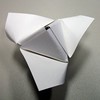
Seen in Jennifer Campbell's pictures, I do not know how to make this unit, but it apparently requires 2 cards to make a tetrahedra and has a "locking mechanism similar to drywall anchors".
Seen in Jennifer Campbell's pictures, I do not know how to make this unit, but it apparently requires 2 cards to make a tetrahedra and has a "locking mechanism similar to drywall anchors".
Seen in Jennifer Campbell's pictures, I do not know how to make this unit, but the name implies that it has a tab/slot configuration like a standard sonobe unit.
Seen in Jennifer Campbell's pictures, I do not know how to make this unit and the description implies that it is difficult to assemble, although I do not believe it would be difficult to fold the units. I do not know how to fold this model currently.
Seen in Jennifer Campbell's pictures, I do not know how to make this unit but the name implies that it is similar to the units used in Tom Hull Five Intersecting Tetrahedra. I believe this will be easy to duplicate when I get around to trying. I do not know how to fold this model currently.
This unit is pictured on Valerie Vann's old site and attributed to Dr. Jeannine Mosely, I assume, as a "J. Mosely Type Unit". I have found no other reference to this unit, and the photo of it is not of a finished model. I do not know how to fold this model.
Pictured on Valerie Vann's old site, this unit apparently requries some glue to keep it together in a 4 card configuration. I do not know how to fold this model.
Pictured on Valerie Vann's old site, this is a simple coaster/ring made with 12 units that appear to have been folded very little. I do not know how to fold this model.
Pictured on Valerie Vann's old site in two places, this appears to be a fairly simple construction similar to Vann's puzzle ring cube. I do not know how to fold this model.
Pictured on Valerie Vann's old site in two places, this appears to be a fairly simple construction similar to Vann's puzzle ring cube. At least one is referred to as "ring bottom style". I do not know how to fold this model.
Pictured on Valerie Vann's old site, this unit is referred to simply as "Double Card Poly". I do not know how to fold this model.
Pictured on Valerie Vann's old site, this appears to be similar to Vann's puzzle ring cube. I do not know how to fold this model.
Pictured on Valerie Vann's old site is an unnamed module that takes 30 units to fold what appears to be a stellated icosahedra. I do not know how to fold this model.
Pictured on Valerie Vann's old site is a vase model with points coming out of the base. It appears to require 5 cards. I do not know how to fold this model.
An unattributed money box model, which I assume to be like a piggy bank, was published in Minori magazine 1998-1. I do not know how to fold this model.
Traditional jumping frogs are easy to fold from a business card and they jump quite well.
There is a fairly simple puppy model with diagrams available. These diagrams are also published in the Origami USA 2002 Collection. This model was designed by Larry Stevens.

There is also a different puppy model.
Jennifer Campbell has adapted the traditional frog model to the business card format.


Origami USA 1998 Collection has diagrams for a business card ram designed by Michael Brunelle. This model is cute, but the head and horns are difficult to shape due to the thickness.

Origami USA 1989 Collection has diagrams for a business card fish designed by Chris Schneider. It is a very simplistic model.

There is also an adaptation of the traditional flapping bird to the business card format.
Gay Merrill Gross published a hopping bunny business card model in Origami USA's Paper #32.
Pig diagrams. This model has a couple of judgement folds and it can get a bit thick, so it's hard not to tear a couple of bits.

Dragon diagrams (five cards) page 1, page 2, and page 3. This model uses box pleating and the cards can get a little thick and hard to manipulate. It also requires glue to hold the parts together, but the effect is nice. There are a couple of areas that do show the reverse side of the cards on the legs.

Jennifer Campbell designed a business card dog model, but I do not have a picture of it that I can post, nor do I know of one on the internet. As far as I know, it is unpublished. I do not know how to fold it.
The book Wings and Things: Origami That Flies has an index card frisbee model called the Penta Flinger that can be folded with business cards, although it is difficult unless the cards are a light card stock and it flies better when folded from larger index cards anyway. Glue is useful for added durability.
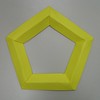

Origami USA 2002 Collection has a business card bow tie designed by Cyril Tessier. It is a fairly simple model.

One dedicated fellow has come up with a method for cuting and folding a few Paris metro tickets to make a cute little X-Wing Fighter. I have not tried it myself, but I imagine that the idea could be adapted to business cards.
The same guy also came up with a similar model of the Millenium Falcon.
Cardahedra is a site that describes how to cut and glue business cards together to form different types of polyhedra. I have not tried any of them myself because I do not like to use cutting and glue very much.
I would like to thank Tom Hull for filling in a few gaps of information and Jennifer Campbell for being a great information source. I would also like to add a special thanks to Tom Fleming for working on expanding the documented models for existing modules and for his work on reverse engineering undocumnted modules. If you are interested in business card origami, here is another useful resource.
Malachi B-J Brown malachus+spencerandbrown@gmail.com